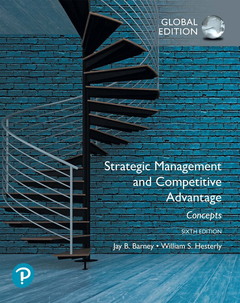Description
Strategic Management and Competitive Advantage: Concepts Global Edition (6th Ed.)
Authors: Barney Jay, Hesterly William
Language: English
Subject for Strategic Management and Competitive Advantage: Concepts...:
Approximative price 89.08 €
In Print (Delivery period: 14 days).
Add to cart392 p. · 20.5x25 cm · Paperback
Description
/li>Contents
/li>Comment
/li>
For courses in strategy and strategic management.
Strategic Management and Competitive Advantage: Concepts strips out the unnecessary, by presenting material that answers the question: does this concept help students analyse real business situations? Each chapter has four short sections that cover specific issues in depth, allowing professors to adapt the text to their particular needs. By utilising this carefully crafted approach, the 6th Edition provides students with the tools they need for strategic analysis.
PART I: THE TOOLS OF STRATEGIC ANALYSIS
1. What is Strategy and the Strategic Management Process?
2. Evaluating a Firm’s External Environment
3. Evaluating a Firm’s Internal Capabilities
END-OF-PART I: CASES PC 1—1
PART II: BUSINESS-LEVEL STRATEGIES
4. Cost Leadership
5. Product Differentiation
6. Flexibility and Real Options
7. Collusion
END-OF-PART II: CASES PC 2—1
PART III: CORPORATE STRATEGIES
8. Vertical Integration
9. Corporate Diversification
10. Organizing to Implement Corporate Diversification
11. Strategic Alliances
12. Mergers and Acquisitions
END-OF-PART III: PC 3—1
Appendix: Analyzing Cases and Preparing for Class Discussions
Glossary
Company Index
Name Index
Subject Index
This title is a Pearson Global Edition. The Editorial team at Pearson has worked closely with educators around the world to include content, which is especially relevant to students outside the United States.
Teach the essentials of strategic management skills with a new approach
· New - Authors provide students with a different technique to learning strategic management skills, excluding models or frameworks that have proven to be theoretically unsound or empirically not substantiated.
· New - Topics that are now covered more completely in non-strategic management texts are no longer included.
· New - Author discussions on strategic management models that provide important insights and have emerged over the years.
Help students develop critical-thinking skills
· New - Chapter Six summarizes the latest theoretical and empirical work on the value of strategic flexibility. It describes the settings under which flexibility will create value, and how that value can be estimated.
· New - Chapter Seven explores the economic -- and ethical -- implications of explicit and tacit collusion. Even if a particular firm chooses to not engage in collusion, it must still understand this strategy and its economic consequences, because some of its competitors may choose this strategy.
· The fundamental concepts include a five forces framework, value chain analysis, generic strategies, and corporate strategy. VRIO framework is used throughout the text to help students understand Strategic Management concepts.
· A discussion on corporate competitive advantage in the product market, is included along with a student’s competitive advantage in the labor market.
· Chapter Three describes the socially complex,




